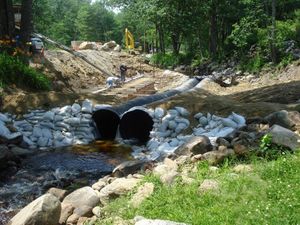
Difference between revisions of "Construction practices to minimize sediment discharge"
m |
m |
||
| Line 8: | Line 8: | ||
[[Acknowledgements for construction stormwater|Acknowledgements]] | [[Acknowledgements for construction stormwater|Acknowledgements]] | ||
| − | *[[Construction stormwater practices - temporary stream crossing]] | + | *[[Construction stormwater practices - temporary stream crossing]] |
| − | *[[Construction stormwater practices - diversion and working in the dry]] | + | *[[Construction stormwater practices - diversion and working in the dry]] |
| − | *[[Construction stormwater treatment - dewatering, including chemical treatment and sediment filtration]] | + | *[[Construction stormwater treatment - dewatering, including chemical treatment and sediment filtration]] |
| − | *[[Construction stormwater treatment - BMP removal after final stabilization]] | + | *[[Construction stormwater treatment - BMP removal after final stabilization]] |
==Photo galleries== | ==Photo galleries== | ||
Revision as of 20:57, 19 July 2022
Erosion is the process by which soil, rock, or other material is moved from one location to another, typically through the action of water or wind. Erosion prevention practices are designed to prevent or minimize erosion.
This page provides links to pages that provide information on practices not specifically considered erosion prevention or sediment control practices, but that are considered good construction practices.
- Construction stormwater practices - temporary stream crossing
- Construction stormwater practices - diversion and working in the dry
- Construction stormwater treatment - dewatering, including chemical treatment and sediment filtration
- Construction stormwater treatment - BMP removal after final stabilization
Photo galleries
- Stabilization practices
- Perimeter control
- Vehicle tracking BMPs
- Outlet energy dissipation
- Check dams (ditch checks, ditch dikes)
- Storm drain inlet protection
Links
- Main construction stormwater page
- Sediment control practices
- General principles for erosion prevention and sediment control at construction sites in Minnesota
- Construction stormwater best management practice – perimeter control fact sheet
- Linear permanent stormwater management design flow chart
- Construction stormwater best management practice – Constructing infiltration systems
- Construction stormwater best management practice – Concrete, paint, stucco and other washout guidance
- EPA Concrete Washout Stormwater Best Management Practice
- Construction stormwater best management practice – buffer zones
- Construction stormwater best management practice – Site stabilization
- Construction stormwater – Top 5 permit violations
Related pages
- Erosion prevention practices - Links to a page that provides a portal to information on individual erosion prevention practices. Contains NEW! information.
- Sediment control practices - Links to a page that provides a portal to information on individual sediment control practices. Contains NEW! information.
- Construction stormwater treatment - Contains NEW! information.
- Construction practices to minimize sediment discharge - Contains NEW! information.
- Winter construction practices for site stabilization, erosion prevention and sediment control - Contains NEW! information.
- General principles for erosion prevention and sediment control at construction sites in Minnesota
- NEW! - 10 Steps to Stormwater Pollution Prevention on Small Residential Construction Sites: An interactive image illustrating stormwater practices at small construction sites.
- Links for construction stormwater
- Construction stormwater inspection checklist

